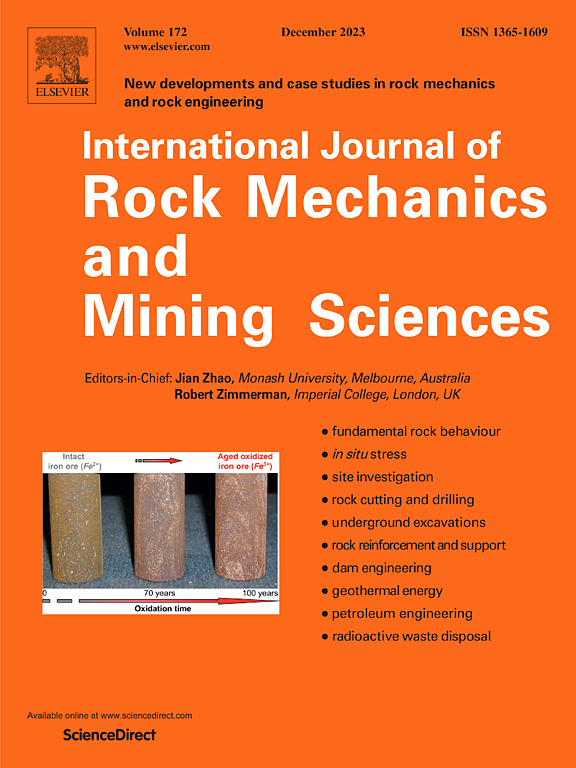Modelling rockbursts around a deep tunnel based on the particle finite element method: From progressive degradation to catastrophic ejection
IF 7
1区 工程技术
Q1 ENGINEERING, GEOLOGICAL
International Journal of Rock Mechanics and Mining Sciences
Pub Date : 2025-04-22
DOI:10.1016/j.ijrmms.2025.106131
引用次数: 0
Abstract
We develop a novel computational framework based on the particle finite element method for simulating rockburst phenomena, from pre-failure initiation to failure evolution and to post-failure mobilisation and ejection, across spatiotemporal scales in hard rocks. The proposed framework builds upon a rigorously validated and extensively calibrated particle finite element model, distinguished by its unique capability to handle large deformation problems. This framework can simultaneously capture the creep damage mechanism based on a time-dependent strength degradation model and the brittle fracturing process based on a cohesion loss-frictional strengthening model. The post-failure mobilisation is further governed by a frictional weakening formulation to capture the associated stress drop behaviour. We consider the intrinsic material heterogeneity assuming a Weibull distribution of rock mass properties and represent the nearby fault zone as a thin continuum layer with equivalent mechanical properties. We apply the model to investigate the processes and phenomena of deep tunnelling-induced rockbursts under different stress and heterogeneity conditions. Our simulation results, grounded in a thoroughly validated modelling framework, yield insights with important implications for understanding and predicting catastrophic rockbursts during deep tunnel excavation. While further site-specific calibration would be required for practical application, the current framework demonstrates strong potential as a predictive tool for evaluating rockburst hazards in complex geological settings.
基于颗粒有限元法的深埋巷道岩爆模拟:从递进退化到突变喷射
我们开发了一种基于颗粒有限元方法的新型计算框架,用于模拟岩爆现象,从破坏前开始到破坏演化,再到破坏后的动员和喷射,跨越硬岩石的时空尺度。提出的框架建立在严格验证和广泛校准的颗粒有限元模型上,以其处理大变形问题的独特能力而闻名。该框架可以同时捕捉基于时间相关强度退化模型的蠕变损伤机制和基于黏聚损失-摩擦强化模型的脆性破裂过程。失效后的动员进一步由摩擦弱化公式控制,以捕获相关的应力下降行为。我们假定岩体性质为威布尔分布,并将附近断裂带表示为具有等效力学性质的薄连续层。应用该模型研究了不同应力和非均质性条件下深部隧道岩爆的过程和现象。我们的模拟结果基于经过彻底验证的建模框架,对理解和预测深隧道开挖过程中的灾难性岩爆具有重要意义。虽然实际应用需要进一步的现场特定校准,但目前的框架显示出强大的潜力,可以作为评估复杂地质环境中岩爆危害的预测工具。
本文章由计算机程序翻译,如有差异,请以英文原文为准。
求助全文
约1分钟内获得全文
求助全文
来源期刊
CiteScore
14.00
自引率
5.60%
发文量
196
审稿时长
18 weeks
期刊介绍:
The International Journal of Rock Mechanics and Mining Sciences focuses on original research, new developments, site measurements, and case studies within the fields of rock mechanics and rock engineering. Serving as an international platform, it showcases high-quality papers addressing rock mechanics and the application of its principles and techniques in mining and civil engineering projects situated on or within rock masses. These projects encompass a wide range, including slopes, open-pit mines, quarries, shafts, tunnels, caverns, underground mines, metro systems, dams, hydro-electric stations, geothermal energy, petroleum engineering, and radioactive waste disposal. The journal welcomes submissions on various topics, with particular interest in theoretical advancements, analytical and numerical methods, rock testing, site investigation, and case studies.

 求助内容:
求助内容: 应助结果提醒方式:
应助结果提醒方式:


